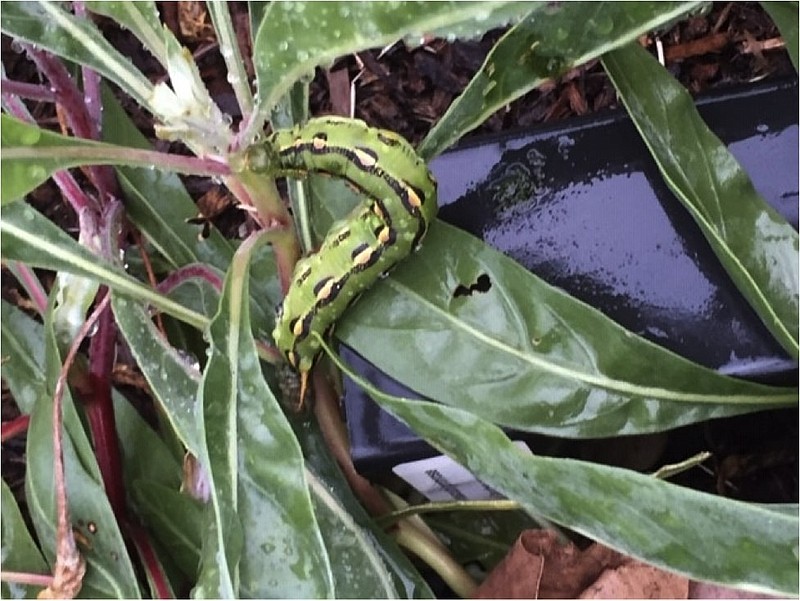Q. What is this interesting caterpillar (see photo)? I found it on evening primrose earlier this summer. Is it a problem?
A. This is the caterpillar of the Whitelined Sphinx moth (Hyles lineata). Sphinx moths are often referred to as "hummingbird moths," due to their characteristic flight. They are delightful and beautiful. They are not considered a garden pest; they munch on a variety of different plants, often weeds. They will feed on the foliage of a number of different vegetable and fruit plants. They tend to prefer foliage closer to the ground or lower growing plants. It is important for gardeners to tolerate the feeding of caterpillars when and where possible, in order for us to enjoy the colorful butterflies and moths. Caterpillars are also a much-needed source of food for many birds.
Q. I struggle to store potatoes and onions very long. They mature when it's hot and humid, and I read we are supposed to store cool. There's nowhere cool in August in Missouri!
A. Got an old refrigerator you can put in your garage or somewhere? That is the easiest way. Set the temperature up a little, at 40 degrees Fahrenheit or a bit higher. Put the potatoes in the produce bins and set the lever to highest humidity. The onions can be stored on the racks. Before you put the onions in the fridge, place in shallow boxes or mesh bags, and cure in open garage or barn for three to four weeks. Since onions are sold at room temperature by most grocers, most consumers don't realize the recommended storage temperature to commercial growers for maximum storage life is refrigerated.
Q. My sweet potatoes have these small holes drilled into them about 1/4 or 1/2 inch deep. They are perfectly round. What is doing this? Can it be prevented? Will they store well?
A. That damage is consistent with wireworms. They are extremely hard to prevent, because you don't really know when they will strike. They are not a worm, but rather a grub stage of the beetle commonly referred to as a "click beetle" for the beetle makes a clicking noise if picked up. A favorite thing for kids to do is put them on their back and watch them click to flip over.
Commercial growers have insecticides available to use for them. Unfortunately, there is nothing I could find for home gardeners. While I found two insecticides labeled for controlling wireworms with home vegetables, neither listed either potato or sweet potato on the label. For me to advise someone (legally) to use a product, both the pest and plant/crop must be listed on the label.
The Midwest commercial vegetable production guide provides this insight:
- Wireworms are most likely to be a problem in fields recently planted to sod or pasture, or in fields that have had a grassy weed problem.
- Try your best to control grass in and around the sweet potatoes, or in the area where you may plant them next year. Also, avoid oats, wheat or rye grass as a cover crop.
- If the holes heal over with callus, they should still store well. I would eat them first to be on the safe side, and if a soft spot develops in that area, eat ASAP or refrigerate and eat soon.
Q. I have so much foxtail in my yard this year. Can you recommend a spray I can use on them to kill after they have emerged, and a long lasting herbicide to suppress them to begin with? I want a game plan for next year.
A. Here are three herbicides rated as controlling foxtail in a typical cool season lawn: Acclaim Extra, Dimension and Tenacity. Carefully review the label, as during hot weather there are often warnings about the potential to damage your lawn. Once foxtail is producing seed heads, it is harder to kill. However, you could test it out this year. Cool weather will reduce foxtail growth, and frost should kill it.
For pre-emergent weed control, both Barricade and Cavalcade are rated as potentially providing longer control. Abundant rainfall or irrigation generally reduces the time these products are effective. Plan ahead to use any of these products; a typical retailer may not carry them.

